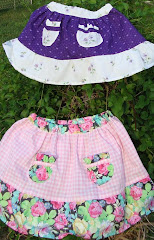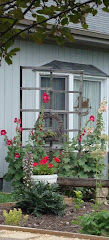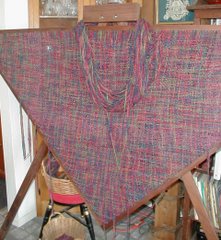 Thanksgiving dinner for 15? It's a cinch.
Thanksgiving dinner for 15? It's a cinch. 45 pie pumpkins? Help!
Thanks to a friend who had too many pie pumpkins DH and I spent Friday canning pumpkin. And, as always, I saved the turkey carcass from Thanksgiving to make turkey broth for canning so Friday's kitchen output included 39 quarts of pumpkin plus 7 quarts of turkey broth.
DS claimed one pumpkin for carving. Why restrict jack o'lanterns to Halloween? After all, that would leave us with only 44 pumpkins. Every little bit helps, you know.
 DH began cutting up pumpkins by 11 a.m. He started out cheerful and slightly goofy. In other words, normal.
DH began cutting up pumpkins by 11 a.m. He started out cheerful and slightly goofy. In other words, normal.He continued carving pumpkins for canning till mid-afternoon when he took DS roller skating, fulfilling a long-promised treat and leaving me with the first batch of pumpkin in the pressure canner plus several pumpkins seeded and sliced and waiting to be peeled, chopped and par-boiled.

All the pumpkin guts and peels went to the animals. The chickens scratched through the stringy seeds and the sheep and Andy found some of the peels palatable. Pumpkin seeds are a natural wormer so I'm saving some of them to grind and add to feed later in the winter, too. I'm wondering if they'd be useful in treating roundworms in T-cat. We can't keep him from indulging in small rodents and sometimes wild birds so he often shows signs of worms as often as once a year.
 I used our new All-American pressure canner which is tall enough to allow a double-stack of quart jars. The first batch only had 12 quarts, though, as I misjudged how much pumpkin to heat for jarring.
I used our new All-American pressure canner which is tall enough to allow a double-stack of quart jars. The first batch only had 12 quarts, though, as I misjudged how much pumpkin to heat for jarring.The second canner held a full 14 quarts. And the last canner of pumpkin for the evening held 13 quarts. It was short one quart because we stopped after prepping 23 pumpkins so I'd still have time to process the turkey broth which had simmered in the roaster oven for most of the afternoon.
 Turkey broth only requires 25 minutes for processing in the pressure canner but pumpkin takes 90 minutes and what with bringing the canner up to pressure each time, processing for the required time and then allowing for cool down till the pressure subsides, only to start the process over again, we were up till after midnight.
Turkey broth only requires 25 minutes for processing in the pressure canner but pumpkin takes 90 minutes and what with bringing the canner up to pressure each time, processing for the required time and then allowing for cool down till the pressure subsides, only to start the process over again, we were up till after midnight. But I love knowing I have all those jars of pumpkin and broth ready to go into the pantry.
Since DH and DS had their monthly wargaming gathering at the county library Saturday afternoon, I decided to take the afternoon off from canning, too. I spent the time writing out a draft and winding the warp for some kitchen towels I want to weave. The 21 remaining pumpkins will keep till Monday.
 We like pumpkin pie all year 'round but I don't make it with the crust. And my sister adapted a traditional pumpkin pie recipe to use half the amount of sugar and milk so DH can argue, somewhat successfully, that pumpkin pie is even suitable for breakfast.
We like pumpkin pie all year 'round but I don't make it with the crust. And my sister adapted a traditional pumpkin pie recipe to use half the amount of sugar and milk so DH can argue, somewhat successfully, that pumpkin pie is even suitable for breakfast. Pumpkin Pie W/O Crust
1 quart home-canned pumpkin, drained and mashed
-OR-
29 ounces commercially-canned pumpkin
4 eggs, lightly beaten
1 can (14 ounces) sweetened condensed milk
-OR-
1 can (12 ounces) evaporated milk AND 3/4 cup sugar

2 teaspoons ground cinnamon
1 teaspoon ground ginger
1 teaspoon ground nutmeg
1/2 teaspoon ground cloves
Preheat oven to 325°F. Lightly oil two 7x11-inch baking dishes.
Whisk ingredients together in order listed. Pour into prepared pans.
Place in oven and bake for 45 to 50 minutes or until knife inserted near center comes out clean.
Note: Substitute up to 1 cup honey or maple syrup for sugar, if desired. Make require slightly longer baking with either of those substitutions.


































































